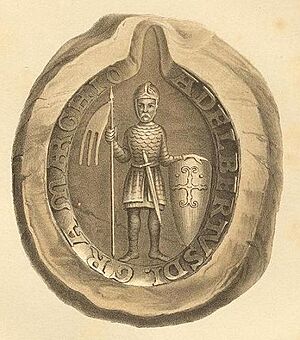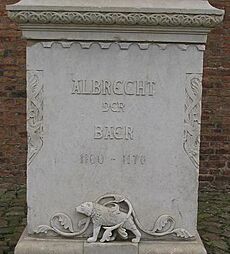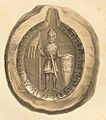Albert the Bear facts for kids
Quick facts for kids Albert the Bear |
|
|---|---|

Effigy on Albert's seal
|
|
| Margrave of Brandenburg | |
| Reign | 1157–1170 |
| Successor | Otto I |
| Born | c. 1100 |
| Died | 18 November 1170 (aged 70) possibly Stendal |
| Burial | Ballenstedt |
| Spouse | Sophie of Winzenburg |
| Issue more... |
Otto I, Margrave of Brandenburg Hermann I, Count of Orlamünde Siegfried, Prince-Archbishop of Bremen Bernhard, Count of Anhalt Hedwig, Margravine of Meissen |
| House | House of Ascania |
| Father | Otto, Count of Ballenstedt |
| Mother | Eilika of Saxony |
Albert the Bear (born around 1100 – died November 18, 1170) was a very important ruler in medieval Germany. He was the first Margrave of Brandenburg, ruling from 1157 until his death. He also briefly held the title of Duke of Saxony between 1138 and 1142. Albert is famous for expanding his lands and helping to create the region we know today as Brandenburg.
Contents
Life of Albert the Bear
Albert was the only son of Otto, Count of Ballenstedt. His mother was Eilika of Saxony, whose family had a lot of land in Saxony. When his father died in 1123, Albert inherited important estates in northern Saxony. Later, in 1142, he also inherited half of his mother's family lands.
Early Conflicts and Land Gains
Albert was a loyal supporter of his relative, Lothar I. Lothar was the Duke of Saxony and later became the King of the Germans. Around 1123, Lothar gave Albert the region of Lusatia, which was to the east. Albert even joined Lothar on a difficult trip to Bohemia in 1126. During this trip, he was briefly held captive.
Albert always wanted to make his lands bigger. His brother-in-law, Henry II, Margrave of the Nordmark, controlled a small area called the Saxon Northern March. When Henry died in 1128, Albert hoped to get this land. But he didn't, so he attacked the heir, Udo V. Because of this, Lothar took Lusatia away from Albert.
Even after these problems, Albert traveled to Italy in 1132 with the king. His help there was rewarded in 1134. He was given the Northern March, which was once again without a ruler.
Becoming Duke of Saxony and Losing It
In 1138, Conrad III, the King of the Germans, took the duchy of Saxony from Albert's cousin, Henry the Proud. King Conrad then offered Saxony to Albert. Albert tried to take control, but Henry and his allies drove him out of Saxony and even from his Northern March. Albert had to flee to southern Germany.
Henry the Proud died in 1139. An agreement was made, and Henry's son, Henry the Lion, became the Duke of Saxony in 1142. In the same year, Albert gave up his claim to Saxony. Instead, he received the counties of Weimar and Orlamünde.
Founding Brandenburg
Once Albert was firmly in charge of the Northern March, he looked to expand into the lands to the north and east. These areas were not very populated and were home to Slavic people called Wends. For three years, Albert fought against the Wends. They were not Christians, and bringing Christianity to them was a goal of the Wendish Crusade in 1147, which Albert joined.
Albert's army helped to take back Havelberg, a town that had been lost for a long time. But he also used smart diplomatic moves. He made a deal with the last Wendish prince of Brandenburg, Pribislav-Henry. When Pribislav-Henry died in 1150, Albert gained control of the Brandenburg region.
Taking the title "Margrave in Brandenburg," Albert continued to expand his territory. He encouraged people from the Netherlands and Germany to settle in the Elbe-Havel region. This movement of people was called Ostsiedlung. He also set up new church districts under his protection. By doing all this, Albert became the founder of the Margraviate of Brandenburg in 1157. His family, the House of Ascania, ruled Brandenburg until 1320.
Later Life and Legacy
In 1158, a disagreement with Henry the Lion, Duke of Saxony, was put on hold when Albert went on a pilgrimage to the Holy Land. When he returned in 1160, he gave land to the Knights of Saint John in memory of his wife, Sofia. He also made a special coin (a pfennig) in her memory.
In 1162, Albert went with Emperor Frederick Barbarossa to Italy. He showed great bravery during the attack on the city of Milan.
In 1164, Albert joined other princes against Henry the Lion. Peace was made in 1169. Albert then divided his lands among his six sons. He died on November 18, 1170, and was buried in Ballenstedt.
Why "The Bear"?
Albert was known as "the Bear." This nickname probably came from the bear symbol on his shield, not because of his looks. People described him as a tall and handsome man. He was known for being very capable and smart. He was a strong leader who knew how to get things done and keep what he gained. He was a very important figure in northern Germany during his time, especially for establishing Brandenburg. He was also sometimes called "the Handsome."
Family Life
Albert married Sophie of Winzenburg in 1124. She died on March 25, 1160. They had many children together. Some of their notable children included:
- Otto I, Margrave of Brandenburg (1126/1128–1184), who became the next Margrave of Brandenburg.
- Count Hermann I of Orlamünde (died 1176).
- Siegfried (died 1184), who became a bishop and later an archbishop.
- Count Bernhard of Anhalt (1138/1142–1212), who became the Duke of Saxony.
- Hedwig (died 1203).
Images for kids
See Also
- Margraviate of Brandenburg
- House of Ascania
- Wendish Crusade




